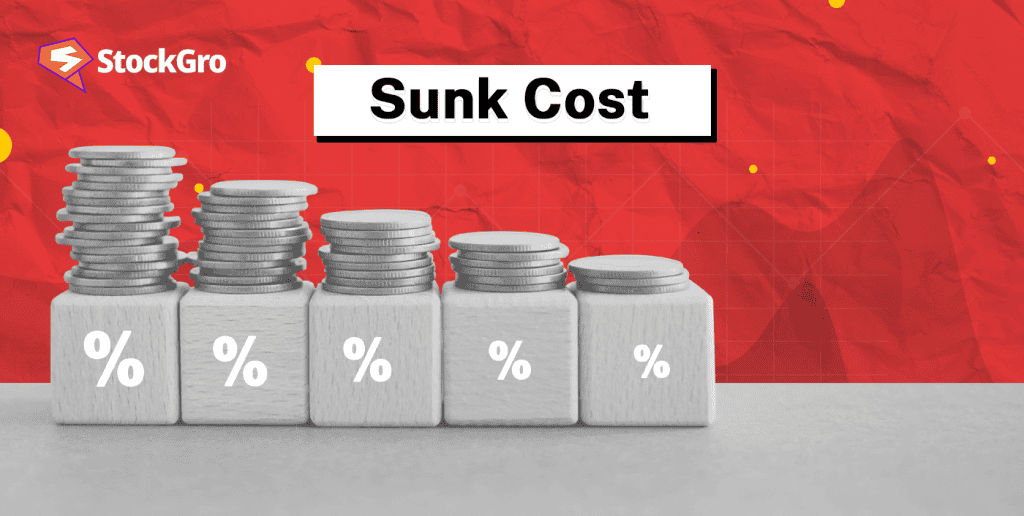
Imagine you’ve invested in a stock that initially looked promising. Over time, the stock starts to fall. You often examine its performance in search of a turnabout, but the losses keep mounting. Though the picture is bleak, you find yourself unable to sell. You think, “I’ve already spent so much on this; maybe it will bounce back.” Sound familiar? This is a classic example of the sunk cost fallacy at work.
When you spend money or resources that you can’t get back, you have a “sunk cost.” When it comes to the stock market, this could mean the money you put into a stock and any transaction fees that you can’t get back, no matter how the stock does in the future.
To make smart, forward-looking decisions in the stock market, you need to understand the idea of “sunk costs.” Not noticing this mental trap can cause long-term losses, missed chances, and emotional stress. These are all mistakes that investors should try to avoid at all costs.
Understanding the concept of sunk costs
What is the definition of sunk cost? A sunk cost is an investment or fee that you have already made and will not get back, no matter what you do in the future. When talking about the stock market, “sunk costs” usually mean the money you’ve already spent on buying stocks, paying broking fees, or anything else that was connected. You can’t get these costs back by hanging on to or selling a stock after they’ve been paid for.
For example, let’s say you put ₹50,000 into a stock that is now only worth ₹30,000 after losing 40% of its value. There is no point in selling the stock now because the ₹20,000 you lost in the drop has already been paid for. Additionally, any broker fees paid during this deal are also considered sunk costs.These costs can’t be recovered, so they shouldn’t change how you make financial decisions in the future.
Sunk costs vs. opportunity costs
| Sunk cost | Opportunity cost | |
| Definition | Expenses already paid for which recovery is impossible. | The possible advantage lost by selecting one investment instead of another. |
| Example | Money spent on buying a stock that has lost value. | The gain you may have gotten from buying a better-performing investment instead. |
| Impact on future decisions | Should not affect the next decisions as they cannot be undone. | Should influence future decisions (since they reflect potential gains or losses). |
| Emotional trap | Results in the sunk cost fallacy—keeping onto unprofitable investments to prevent loss realisation. | Encourages comparing alternatives, ensuring better allocation of resources. |
| Investor focus | Past expenditures | Future potential gains |
| Stock market scenario | Holding a stock in decline due to the amount already invested. | Missing out on a high-growth stock because funds are tied in a poor performer. |
The sunk cost fallacy in the stock market
The sunk cost fallacy is a psychological tendency that occurs when investors make irrational decisions by considering costs that have already been incurred and cannot be recovered. Rather than assessing future possibilities, the emphasis stays on past losses, which results in emotionally motivated actions that can compromise portfolios even more.
The sunk cost fallacy is significantly influenced by emotions including regret, anxiety, and pride. Behavioural economics holds that these feelings can impede investors from acting rationally.
Also read: Stock Market Psychology: Trading Tips, Fear, Greed & More
Why do investors fall into this trap
- Emotional attachment to losses: Investors become emotionally attached to a stock when they pour money into it, which makes let-off difficult. Their judgement is distorted by this attachment, which drives people to hang onto a losing investment in the hope it will recover. Letting go of a terrible stock implies, for many people, acknowledging the investment was a mistake—a difficult emotional choice.
Example – Buying a stock for ₹500 and seeing it drop to ₹300, an investor can hesitate to sell thinking it will finally return to ₹500. The emotional commitment to the original ₹500 price keeps the investor from reducing their losses even if future market conditions reveal little possibility for recovery.
- Fear of admitting a wrong decision: Admitting to have made a poor investment feels like embracing personal failing. Selling underperforming equities makes many investors face the truth that their choice was incorrect. This causes one to hang onto equities far longer than required in search of a maybe non-existent rebound.
Example – Imagine a retail investor who purchases a small company’s shares with great expectations only to see the company’s performance worsen. Selling those shares forces many investors who would rather wait—even in the face of growing losses—to admit that their investment was a bad one.
- Bias toward optimism about recovery: A common mistake investors make is to hold on to the hope that a bad stock will get better, even when all the signs say otherwise. They stay with bad choices for longer than they need to because of this optimism bias. A lot of the time, buyers hold on to bad stocks because they think “things will turn around” and that the stocks will get better over time.
Example – Rajesh paid ₹500 a share in TechDreams Ltd. Though bad performance caused the stock to drop below ₹200, he persists in expecting a comeback. His optimism bias keeps him from selling, which causes more losses instead of reallocating to better possibilities.
Also read: How to Monitor Your Stock Portfolio and Keep It in Check
Recognising and avoiding the sunk cost trap
- Regularly review your portfolio: Evaluate every asset’s performance using future potential rather than historical performance. Showcase stocks that no longer fit your objectives.
- Set clear investment goals: Before starting a trade, define success criteria and goal returns. Review jobs that fall short of these standards.
- Practise objective decision-making: Base choices on facts and analysis rather than feelings. Pay especially attention to financial statements, market trends, and economic data.
- Seek external opinions: To separate from emotional relationships, consult financial advisers or other investors. From outside angles, one can find chances to minimise losses.
- Be mindful of emotional triggers: Acknowledge emotions like pride or regret that cause one to hang onto lost money. Try for logical, fact-based judgements.
- Implement stop-loss orders: Use stop-loss orders to automatically sell equities at defined prices, therefore lessening emotional turmoil with underperforming investments.
- Reflect on past decisions: Study past investment errors to prevent repeating them. When assessing present investments, spot indicators of emotional involvement.
- Stay informed and educated: Study behavioural finance and market dynamics constantly to find and get around the sunk cost fallacy.
- Accept the reality of losses: Recognise that investment naturally results in losses. Emphasise prospects ahead rather than moping over past mistakes.
Psychological tools to combat sunk cost fallacy
Cognitive behavioural techniques
Cognitive Behavioural Techniques help in challenging faulty investing assumptions by employing the identification of cognitive distortions including “all-or-nothing” thinking.
By posing important questions like “Does this stock still align with my goals?” investors can objectively assess present data rather than past losses. Turning the emphasis to possible future results instead of past expenditures and visualising future events can help to direct more wise decisions.
Mindfulness and emotional detachment
Use mindfulness practices including meditation or deep breathing to become conscious of your ideas and emotions, therefore enabling you to see emotional prejudices in your financial decisions.
See investments as tools rather than personal attachments to make objective decisions depending on performance and market situation. Examine performance indicators and market trends often to make sure your selections are based on facts and therefore reduce the impact of emotions.
Building a decision-making framework
Specify exact standards for purchasing and selling equities, including performance benchmarks and price targets, therefore defining precise criteria. Create a review system to routinely evaluate investments so that decisions are grounded in current facts rather than feelings.
Record the justification for every investment to help you to better match your general approach. Analyse investments and industry trends using data analytics instruments to support facts-driven judgements over emotional ones.
You may also like: Prospect theory: How we assess gains & losses in behavioural finance
Bottomline
Making reasonable stock market investments depends on an awareness of the sunk cost fallacy. Investors can escape the emotional traps of hanging onto underperforming equities by realising that past losses shouldn’t control future behaviour.
A disciplined approach can be developed by applying techniques including frequent portfolio reviews, well-defined investment goals, and mindfulness-based psychological tools.
In the end, knowing that losses are inevitable in investing helps one to concentrate on future prospects instead of previous mistakes, therefore guiding investors towards actions consistent with their financial goals.
FAQs
What is a sunk cost in stocks?
In equities, a sunk cost is money previously invested in a stock that cannot be recouped. It is the historical cost of a stock independent of its present or future performance. Investors who hang onto losing stocks out of emotional attachment to the original investment instead of making logical judgements based on the stock’s present value and future potential suffer from the sunk cost fallacy.
What are examples of sunk costs?
Sunk expenditures include things like broker fees, initial stock purchases, and research and development expenses for items never launched as well as non-refundable expenses. These expenses are already paid for and cannot be undone independent of future behaviour. In the stock market, the money spent on buying shares that have since lost value is a sunk cost, therefore impacting decisions if not carefully controlled.
What is the opposite of a sunk cost?
A prospective cost is the opposite of a sunk cost. Prospective costs are those future expenses under the influence of present choices. Prospective costs should be carefully examined while planning investments or corporate strategies since they might influence the whole financial result unlike sunk costs, which are irreparable and should not influence future decisions. These are the expenses you still have free will to control or avoid.
Are sunk costs bad?
Although they are not inherently bad, sunk costs can cause negative decisions if they affect decisions to be made going forward. The main problem is when emotionally attached to past expenses individuals hang onto failing investments. Understanding sunk costs enables one to concentrate on future possibilities instead of past losses, therefore guiding more logical and wise judgements. Eliminating sunk expenses can help to enhance general investment plans.
What is the sunk cost paradox?
The sunk cost paradox arises when people keep funding a project or decision despite data pointing out that it would be wiser to cut losses. The amount already invested determines this. This paradox exposes illogical behaviour when the choice to keep on is motivated by past expenses instead of future gains. Understanding this will enable more logical, forward-looking judgements to be made, therefore preventing additional unneeded expenditures.

